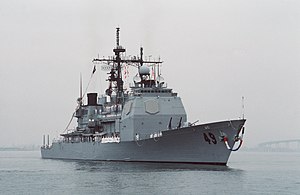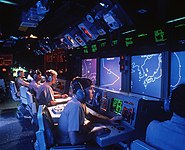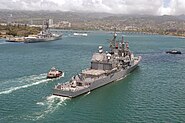| USS Vincennes (CG-49) | |
|---|---|
 Vincennes pulls into port at San Diego, California, on 24 October 1988. | |
| Career (U.S.) | |
| Name: | Vincennes |
| Namesake: | Battle of Vincennes |
| Ordered: | 28 August 1981 |
| Builder: | Ingalls Shipbuilding |
| Laid down: | 19 October 1982 |
| Launched: | 14 April 1984 |
| Sponsored by: | Marilyn Quayle |
| Acquired: | 3 June 1985 |
| Commissioned: | 6 July 1985 |
| Decommissioned: | 29 June 2005 |
| Struck: | 29 June 2005 |
| Motto: | Freedom's Fortress |
| Fate: | Sold to International Shipbreaking 9 July 2010 |
| Status: | Scrapped |
| General characteristics | |
| Class & type: | Ticonderoga-class cruiser |
| Displacement: | Approx. 9,600 long tons (9,800 t) full load |
| Length: | 567 feet (173 m) |
| Beam: | 55 feet (16.8 meters) |
| Draft: | 34 feet (10.2 meters) |
| Propulsion: |
|
| Speed: | 32.5 knots (60 km/h; 37.4 mph) |
| Complement: | 33 officers, 27 Chief Petty Officers, and approx. 340 enlisted |
| Sensors and processing systems: |
|
| Armament: |
|
| Aircraft carried: | 2 × Sikorsky SH-60B or MH-60R Seahawk LAMPS III helicopters. |
The USS Vincennes (CG-49) was a Ticonderoga-class Aegis guided missile cruiser in service with the United States Navy from July 1985 to June 2005. Decommissioned in 2005, Vincennes was sold for scrapping to International Shipbreaking in July 2010, and finished scrapping by the end of November 2011.
Vincennes is best known for shooting down an Iranian civilian passenger jetliner, Iran Air Flight 655, over the Persian Gulf on 3 July 1988, killing all 290 civilians on board (including 38 non-Iranians and 66 children), sparking an international incident between the Islamic Republic of Iran and the United States of America.
History[]
1980s[]
Vincennes was launched on 14 April 1984 and sponsored by Marilyn Quayle, wife of Indiana Senator Dan Quayle. Vincennes was named for the Battle of Vincennes during the American Revolutionary War, while the previous Vincennes heavy cruiser and Vincennes light cruiser were named for the city of Vincennes, Indiana. She was commissioned at Pascagoula 6 July 1985, Captain George N. Gee in command. The ship normally carried guided missiles, rapid-fire cannons, and two Seahawk LAMPS helicopters for anti-submarine and anti-ship warfare, personnel transfers, and other purposes.
Vincennes was the first of the Ticonderoga class cruisers to enter the Pacific Fleet. Upon commissioning in 1985, Vincennes helped test the SM-2 Block II surface-to-air missile. In May 1986, Vincennes participated in the multinational exercise RIMPAC 86, coordinating the anti-aircraft warfare efforts of two aircraft carriers and more than 40 ships from five nations. The Vincennes was deployed in August 1986 to the Western Pacific and Indian Oceans. The ship served as anti-air warfare commander with the Carl Vinson and New Jersey battle groups, operated with the Japan Maritime Self-Defense Force and the Royal Australian Navy, and steamed more than 46,000 miles (74,000 km) in waters from the Bering Sea to the Indian Ocean.[1][2]
Iran-Iraq War[]
During the Iran-Iraq War the United States took active measures in the Persian Gulf to protect shipping, mainly oil tankers, that were being threatened by both countries.
Operation Earnest Will[]
On 14 April 1988, the guided missile frigate Samuel B. Roberts hit a mine in the Persian Gulf during Operation Earnest Will. Six days later, Vincennes was re-deployed from Fleet Exercise 88-1, sent back to San Diego, California and told to prepare for a six-month deployment. The reason for the haste: Navy leaders decided that they needed an Aegis ship to protect the exit of the damaged Roberts through the Strait of Hormuz. One month later, the cruiser entered the Persian Gulf, and in early July, stood guard in the Strait as the damaged frigate was borne out on the Mighty Servant 2 heavy-lift ship. The ship made 14 Hormuz transits during its Earnest Will operations.
Iran Air Flight 655 tragedy[]
On 3 July 1988, Vincennes, under the command of Captain Will Rogers III, fired two radar-guided missiles and shot down an Iran Air Airbus A300 civilian airliner over Iranian airspace in the Strait of Hormuz, killing all 290 passengers and crew on board. According to Captain Rogers, they were being attacked by eight Iranian gun boats. Vincennes was defending itself from this attack when the plane was shot at with two Standard missiles. Crucially, the Vincennes misidentified the Iranian Airbus as an attacking F-14 Tomcat fighter aircraft. A radio warning had been sent to the aircraft on the international air distress frequency. CNN showed video from the area where they found plane wreckage, 25 miles away from the location that Vincennes fired the two Standard missiles. Also noted from CNNs video footage was the lack of other floating debris such as luggage, airplane seat cushions and clothing on the victims seeing that all bodies recovered were bloated and floating hours after they passed.
The Iranian government has maintained that the Vincennes knowingly shot down the civilian aircraft.[3] Iran Air flight IR655 flew every day out of Bandar Abbas—a civil as well as military airport—on a scheduled passenger flight to Dubai using established air lanes. The Italian navy and another US warship, the frigate Sides, confirmed that the plane was climbing—not diving to attack—at the time of the missile strike. The U.S. radio warnings were only broadcast on 121.5 MHz, not air traffic control frequencies and mistakenly identified the altitude and position of the plane, so the Airbus crew, if they were monitoring "guard," could have misinterpreted the warnings as referring to another aircraft. Captain David Carlson of the Sides later said that the destruction of the airliner "marked the horrifying climax to Rogers' aggressiveness".[4]
1990s[]
In February 1990, Vincennes was deployed on a third six-month tour of the western Pacific and Indian oceans, with SH-60 helicopters from HSL-45 Detachment 13. The ship coordinated all battle group air events and served as the command-and-control flagship during Harpoon-Ex-90. In July 1990, Vincennes returned home after steaming nearly 100,000 miles (160,000 km).[1][2]
In August 1991, Vincennes departed for a fourth western Pacific deployment. Steaming with Independence, Vincennes performed duties as the anti-air warfare commander for Battle Group Delta until detaching to participate as the United States representative in MERCUBEX 91, a joint United States and Republic of Singapore Navy exercise. Over the next three months, Vincennes participated in the bilateral exercise Valiant Blitz with the South Korean Navy, the bilateral exercise Annualex 03G with the Japanese Maritime Self Defense Force, and ASWEX 92-1K with the South Korean Navy before reaching Hong Kong to act as the U.S. representative for the Navy Days ceremonies. Vincennes returned from deployment on 21 December 1991.
In June 1994, Vincennes departed on a fifth western Pacific deployment with the Kitty Hawk Battle Group. Vincennes performed duties as anti-air warfare commander for the battle group. During deployment, Vincennes conducted an anti-submarine exercise, PASSEX 94-2, with the Japan Maritime Self-Defense Force, the bilateral exercise MERCUB 94-2, a joint U.S. and Singaporean Navy exercise of the Malaysian peninsula, the bilateral exercise Keen Edge, with the Japan Maritime Self-Defense Force, and Tandem Thrust, a larger-scale joint exercise which Vincennes participated as the area air defense coordinator for the entire joint operating area. Vincennes returned from this deployment on 22 December 1994.
In August 1997, Vincennes changed homeport from San Diego to Yokosuka, Japan, then steamed to the South Pacific and took part in Exercise Valiant Usher 98-1 with the Belleau Wood amphibious ready group and the Royal Australian Navy destroyer HMAS Perth. The combined exercise took place near Townsend Island, Australia.
Vincennes also took part in the U.S. Seventh Fleet's Fleet Battle Experiment Delta (FBE-D) from 24 October 1998, to 2 November 1998, in conjunction with the exercise, Foal Eagle, a regularly scheduled exercise that simulates the military defense of South Korea. Sponsored by the Navy Warfare Development Command, FBE-D was the fourth in a series of experiments that tested new combat systems and procedures at sea.
2000s[]
On 12 August 2000, Vincennes completed Sharem 134, a bilateral exercise with several Japanese ships and other U.S. participants. The exercise included a week of undersea warfare training and data collection in the South China Sea. The ship tested its submarine detection, sonar range testing, and sonobuoy employment and developed new submarine prosecution procedures. The final Sharem events included a "freeplay", which allowed the cruiser to detect and prosecute other submarines, combining many of the tactics and systems tested during Sharem.
In mid-November 2000, the cruiser fired missile batteries at remote-controlled aerial drones provided by Fleet Activities Okinawa during MISSILEX 01-1.
On 23 March 2001, Vincennes, as part of the Kitty Hawk Battle Group, cruised into Changi Naval Base, the first time a U.S. carrier had moored pierside in Singapore. Vincennes took part in a 23 August 2001 to 27 August 2001, military training exercise called Multi-Sail, which was designed to provide U.S. and Japanese forces interoperability training in multiple warfare areas.
Vincennes departed from Yokosuka on 17 September 2001, to conduct operations in support of Operation Enduring Freedom. The ship returned on 18 December 2001 after more than three months at sea.
In March 2003 Vincennes was assigned to Destroyer Squadron 15.[5]
Decommissioning[]
Vincennes was decommissioned on 29 June 2005 at San Diego, California and was stricken later that day. She was mothballed at the Naval Inactive Ship Maintenance Facility in Naval Base Kitsap, in Bremerton, Washington. In 2008, Vincennes was slated for scrapping within the next five years along with her sister ships Thomas S. Gates and Yorktown.
On 9 July 2010, a contract to scrap Vincennes was issued to International Shipbreaking, Brownsville, Tx.[6] On 21 November 2010, Vincennes arrived via the Panama Canal to International Shipbreaking in Brownsville, Texas, and was completely scrapped by 23 November 2011.[7]
Awards and decorations[]
Vincennes has been awarded the Navy Meritorious Unit Commendation, the Battle Efficiency "E" three times, the Combat Action Ribbon, the National Defense Service Medal, and the Sea Service Deployment Ribbon with four stars.
Image gallery[]
References[]
- ↑ 1.0 1.1 "USS Vincennes Checkmate Cruiser CG 49". http://web.archive.org/web/20050306222621/www.vincennes.navy.mil/history.html. Retrieved 26 December 2012.
- ↑ 2.0 2.1 "History of USS VINCENNES". http://www.navysite.de/cg/cg49.html. Retrieved 26 December 2012.
- ↑ Fox Butterfield (15 July 1988). "Iran Falls Short in Drive at U.N. To Condemn U.S. in Airbus Case". The New York Times. http://query.nytimes.com/gst/fullpage.html?res=940DEED91731F936A25754C0A96E948260.. New York Times 15 July 1988. Retrieved 2008-01-10
- ↑ Robert Fisk 'The Great War For Civilisation' (2005) pages 320–328 ISBN 978-1-84115-008-6
- ↑ http://www.hazegray.org/worldnav/usa/suface.htm. Retrieved May 2012
- ↑ www.navsea.navy.mil. "Inactiveships – scrappedships". www.navsea.navy.mil. http://www.navsea.navy.mil/teamships/Inactiveships/Ship_Disposal/scrappedships.aspx. Retrieved 2012-02-07.
- ↑ www.navsea.navy.mil. "Navy Inactive Ships Program SHIP Disposal Program: Dismantling Listing". www.navsea.navy.mil. http://www.navsea.navy.mil/teamships/Inactiveships/Ship_Disposal/pdf/dismantling_listing_05dec2011.pdf. Retrieved 2012-02-07.
- This article incorporates text from the public domain Dictionary of American Naval Fighting Ships. The entry can be found here.
- This article includes information collected from the Naval Vessel Register, which, as a U.S. government publication, is in the public domain. The entry can be found here.
Further reading[]
- Rogers, Will and Sharon Rogers (1992). Storm Center: The USS Vincennes and Iran Air Flight 655 : A Personal Account of Tragedy and Terrorism. Annapolis: Naval Institute Press. ISBN 1-55750-727-9.
- Wise, Harold Lee (2007). Inside the Danger Zone: The U.S. Military in the Persian Gulf 1987–88. Annapolis: Naval Institute Press. ISBN 1-59114-970-3. http://www.insidethedangerzone.com.
- Hennessy, M. Shawn (2009). Freedom's Fortress: Vincennes' History of Service to the United States. Seattle: MS Hennessy Publishing. ISBN 0-615-29191-0. http://www.ussvincennes.org/FreedomsFortress.
External links[]
| Wikimedia Commons has media related to USS Vincennes (CG-49). |
- Naval Vessel Register CG-49
- WebArchive.org – Archive of Official ship's history page from 2005
- Nayvsite.de – USS Vincennes page
- NavSource.org – CG-49
- dod.mil – Investigation Report for the downing of Iran Air 655
| |||||||||||
The original article can be found at USS Vincennes (CG-49) and the edit history here.




